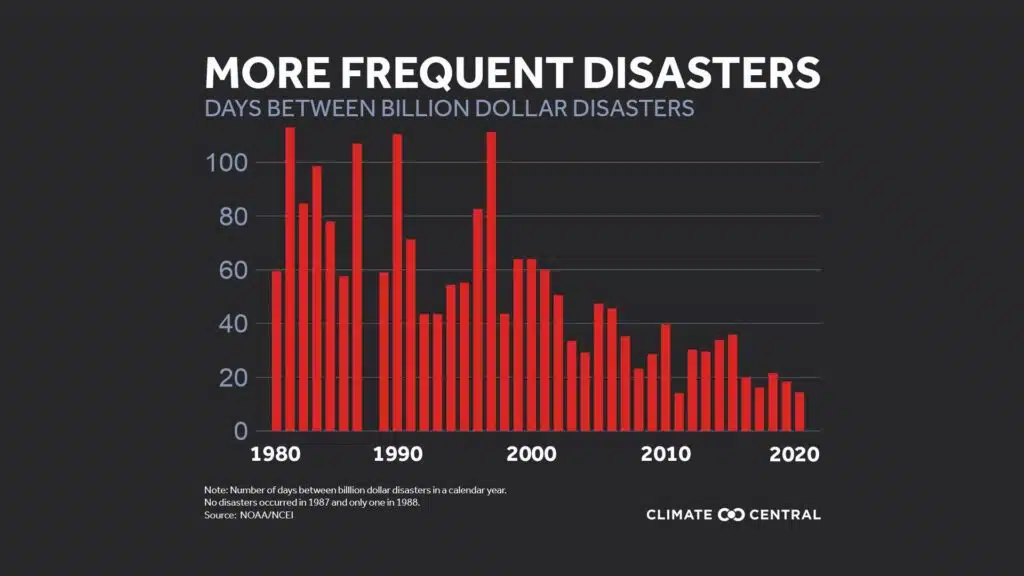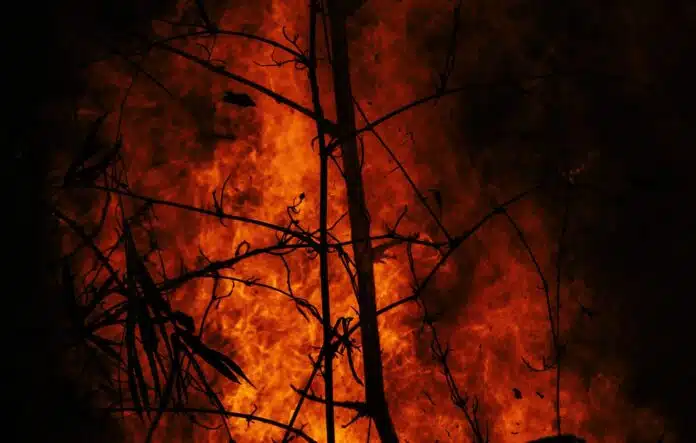As of Oct. 8, 18 billion-dollar disasters have occurred in the United States in 2021, with the country on pace to surpass 2020, which saw a record high of 22 billion-dollar disasters, according to a new report released Friday by the National Oceanic and Atmospheric Administration (NOAA).
In 2020, I did 3 articles (below) addressing the very active year we had in regards to the record breaking wildfire and hurricane seasons. Following the pattern we’ve been experiencing for years now, this year too is breaking records, so much so that we are on track to exceeding the number of billion dollar disasters.
According to AccuWeather, 18 billion dollar disasters have occurred this year compared to 2020’s 22 billion dollar disasters. However, despite the fact that at this time we’re still 4 billion dollar disasters away from meeting (and maybe beating – God forbid) last year’s record, the dollar amount already exceeds what we saw in 2020.
In 2021, the cost of disasters in the country has already exceeded the economic cost of all of 2020’s disasters. Weather and climate disasters have not only killed 538 people thus far this year, but they have also cost the U.S. $104.8 billion in damages…In 2020, the 22 billion-dollar weather and climate disasters in the U.S. cost just under $100 billion in damages, according to NOAA. (Accuweather)
So this begs the question, what is causing this spike in billion dollar disasters? Something Christians have been saying for years and is also what the secular world is admitting – that these disasters are increasing in frequency and intensity, “According to the latest report from the Intergovernmental Panel on Climate Change, it is an ‘established fact’ that human-caused greenhouse gas emissions have “led to an increased frequency and/or intensity of some weather and climate extremes since pre-industrial times,'” (AccuWeather).

I called our attention to this same thing in my article, West Coast up in Flames, where I refer to a 2020 NBC News article, Think 2020′s disasters are wild? Experts say the worst is yet to come, which echoed this sentiment, “Freak natural disasters — most with what scientists say likely have a climate change connection — seem to be everywhere in the crazy year 2020. But experts say we’ll probably look back and say those were the good old days, when disasters weren’t so wild. ‘It’s going to get A LOT worse,’ Georgia Tech climate scientist Kim Cobb said Wednesday. ‘I say that with emphasis because it does challenge the imagination. And that’s the scary thing to know as a climate scientist in 2020.’…’I strongly believe we’re going to look back in 10 years, certainly 20 and definitely 50 and say, ‘Wow, 2020 was a crazy year, but I miss it…'”
Compounding the economic toll that these disasters are taking on the U.S. is the increasing frequency of these devastating blows to the country. The time between billion-dollar disasters has dropped to just 18 days on average between 2016-2020, according to Climate Central’s analysis of new NOAA data. The number of days between disasters has quickly accelerated; in the 1980s, a span of 82 days was the average time between billion-dollar disasters in the United States. (Accuweather)
The United Nations weather agency, in September, gave the same warning, “Weather disasters are striking the world four to five times more often and causing seven times more damage than in the 1970s…” (The Guardian). Although we reach the same conclusion, we’re perceiving the current state of the world with a different pair of lenses. AccuWeather also recently reported that parts of northern Italy experienced a “historic” rainfall of such a magnitude that it set a new continent-wide record leaving one city with a year’s worth of rainfall in one day.
Here in the US we saw record fires, floods, and droughts, the largest wildfire in history on Hawaii’s Big Island, and in Greece, the wildfires were seen as the “greatest ecological catastrophe” they’ve had in decades.
The Guardian reported that July was the world’s hottest month ever recorded and to top it off, a coming “moon wobble” is expected to lead to “‘a decade of dramatic increases in flood numbers’ in the 2030s,” (MSN). The uptick in strange and severe weather patterns is causing confusion for the world but it’s no surprise to the serious student of the bible. In fact, it’s exactly what we’re expecting to see.
In Matthew 24:3-8, Jesus gives a list of things to watch out for that will indicate the end of the age, all things that will have their ultimate fulfillment during the tribulation. After giving a list of signs he says these are the “beginning of sorrows”, other translations render this as “birth pangs”. In essence, Jesus is likening the signs as birth pangs, or contractions.
When a woman’s in labor the contractions get closer and closer in frequency and increase in intensity the closer the time is for the baby’s arrival. Likewise, this is how Jesus likens His coming along with these signs. From this, we understand from scripture that as Jesus’ return draws near, natural disasters will continue to increase in frequency and intensity, drastically explode in the tribulation, culminating in the return of our Lord and the millennial kingdom.
So if this has its ultimate fulfillment during the tribulation, it should show us that the time period is indeed drawing near, and even closer than, the rapture of the church. For the bible believer, none of this catches us by surprise but instead validates God’s word concerning what the last days will look like prior to Christ’s return.
US on pace to exceed record number of billion-dollar disasters in 2021
AccuWeather: In 2021, the cost of disasters in the country has already exceeded the economic cost of all of 2020’s disasters. Weather and climate disasters have not only killed 538 people thus far this year, but they have also cost the U.S. $104.8 billion in damages. Of the 18 disasters, one was a drought, two were flooding events, nine were severe weather events, four were tropical cyclones, one was a wildfire and one was a winter storm.

In 2020, the 22 billion-dollar weather and climate disasters in the U.S. cost just under $100 billion in damages, according to NOAA.
The southern United States has been dealt a significant blow this year, with Hurricane Ida standing as the most damaging disaster of the year to date, costing at least $64.5 billion in damages and leading to 96 deaths. Ida caused near-total destruction in coastal Louisiana, where it made landfall before knocking out power to a significant part of the New Orleans area. Ida then tracked through the Northeast as a tropical rainstorm, spawning an EF3 tornado and record flash flooding in Pennsylvania, New York and New Jersey, killing dozens.
Other tropical systems made the list too, with Hurricane Nicholas and Tropical Storms Elsa and Fred all causing more than $1 billion in damages after striking the Gulf Coast.
Ida was not the deadliest disaster of the year, though. That unwanted distinction goes to the still-ongoing drought and unprecedented June heat wave in the Pacific Northwest, which has killed at least 229 people.
Compounding the economic toll that these disasters are taking on the U.S. is the increasing frequency of these devastating blows to the country. The time between billion-dollar disasters has dropped to just 18 days on average between 2016-2020, according to Climate Central’s analysis of new NOAA data. The number of days between disasters has quickly accelerated; in the 1980s, a span of 82 days was the average time between billion-dollar disasters in the United States. Read More

Sources
- US on pace to exceed record number of billion-dollar disasters in 2021 (October 8th, 2021) – AccuWeather
- 34 inches of rain in 24 hours breaks continental record (October 7th, 2021) – AccuWeather
- 34 inches of rain in 24 hours breaks continental record (October 7th, 2021) – AccuWeather
- Weather disasters ‘stronger and more frequent than in 1970s’ (September 1st, 2021) – The Guardian
- July was world’s hottest month ever recorded, US scientists confirm (August 13th, 2021) – The Guardian
- Greek PM: Wildfires the worst ecological catastrophe in decades (August 12th, 2021) – The Times of Israel
- ‘A perfect storm’: Hawaii firefighters confront Big Island’s largest wildfire in history (August 4th, 2021) – The Guardian
- Fires, Floods and Drought Continue to Plague Western States, 22,000 Firefighters Battle the Blazes (August 3rd, 2021) – CBN News
- Brace for flooding. A moon ‘wobble’ is coming, NASA warns (July 14th, 2021) – MSN




“Bible prophecy is not meant to scare but to prepare. These things were revealed to us so that we have confidence in God’s word and believe in Jesus (John 13:19).” Well said, Ayo. Many these days (even some Christians) are fearful, but if we know Christ there is no reason to be afraid. When we see these things come to pass, we can (as you said above) have confidence in God’s word and our faith can be strengthened. And those who don’t yet know Christ, can believe in Jesus because they see that God’s word is true. Blessings.
Amen! And hopefully sharing the truth like this will bring comfort to many believers and be used as a means to share the gospel with the unsaved.
Yes, I agree. 🙂